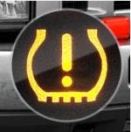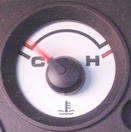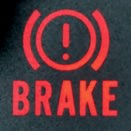 By Katie LaBarre | US News.com – Fri, Aug 19, 2011
By Katie LaBarre | US News.com – Fri, Aug 19, 2011
Summer's a prime time for road trips, but logging hundreds of miles also means you’re more likely to encounter vehicle trouble. Warning lights can make any driver nervous, but if you know what each light means, you’ll be able to handle any problems that arise.
Oil Pressure Warning Light
 Imagine the sound of two pieces of steel grinding together without a lubricant. That’s the sound your car could make without enough oil. The oil pressure light doesn’t tell you when it’s time for an oil change (although some cars can do that), but it will tell you if there are low levels of oil, or if the oil pressure is low. This could be a result of a punctured oil pan, a leak or a number of problems. If your oil pressure warning light turns on, pull over safely, turn off your car immediately and add oil. If you run the engine without oil, it will seize because the metal parts won’t be able to move against each other. That kills your engine.
Imagine the sound of two pieces of steel grinding together without a lubricant. That’s the sound your car could make without enough oil. The oil pressure light doesn’t tell you when it’s time for an oil change (although some cars can do that), but it will tell you if there are low levels of oil, or if the oil pressure is low. This could be a result of a punctured oil pan, a leak or a number of problems. If your oil pressure warning light turns on, pull over safely, turn off your car immediately and add oil. If you run the engine without oil, it will seize because the metal parts won’t be able to move against each other. That kills your engine.
The cost of diagnosing and fixing an oil leak on a 2007 Honda Accord with a 2.4-liter four-cylinder engine can cost between $396 and $534, according to RepairPal. That’s a lot to dish out at once, but it’s less than replacing a seized engine, which can cost $5,000 or more.
Check Engine Warning Light
In most cars, the check engine light and the onboard diagnostics light are the same thing: They indicate that there is a problem in the engine or the emissions system. If this light is on you could have a minor problem like a loose gas cap. But you could also be facing more serious issues, like fuel leaking into the exhaust pipe. If this happens, the fuel could damage the catalytic converter, a component that helps clean your exhaust fumes and is expensive to fix. Replacing both catalytic converters in a 2009 Ford F-150 with a 4.6-liter V8 engine could cost up to $4,302, according to RepairPal.
Tire Pressure Warning Light
Under-inflated tires can lose traction, increase a vehicle’s stopping distance and can make blowouts more likely. Since 2006, all vehicles in the U.S. are required to have a standard tire pressure monitoring system. A standard warning light has two parts: a low tire pressure warning and a tire pressure failure warning. If a tire pressure light comes on, you can find a gas station where you can check your tire pressure and add air, pull over and replace the tire or drive your car to a maintenance shop. If you have run-flat tires, you’re in luck. Most run-flat tires can drive up to 60 miles without damaging your wheels. Some auto reviewers say that run-flat tires ride rougher than traditional tires, but to most of us, peace of mind in case of a flat is more important than how your car will perform on a race track. On the other hand, driving after a tire has completely blown will ruin your rims, adding thousands of dollars to your repair cost.
Engine Temperature Warning Light
Keep a watchful eye on your engine temperature gauge, which tells you how hot the engine is. If your engine is overheating, a small thermometer, a picture of a radiator or the word “temp” might light up. Usually, this temperature gauge notifies the driver that there is a problem with the engine’s coolant system. If the temperature light turns on, pull over to the side of the road and wait until the gauge falls back to the halfway mark. Remember, never pour water over a hot engine, and never open the radiator cap until the engine has fully cooled. Rather than cooling the engine down, dousing hot metal with cold water can result in dangerous amounts of steam and can warp or crack the metal. Opening up the radiator while it’s still hot can release a boiling radiator fluid that can badly burn your hands or face. If you don’t take this light seriously, you could damage your vehicle’s internal parts significantly. Hoses can burst, gaskets can blow and if aluminum cylinders expand too much, the engine could seize. Get to a shop immediately, where they can diagnose and fix the problem.
Brake Warning Light
Generally, the brake warning light turns on if pressure in the brake system has changed because of leaking or overheating brake fluid. Since disc brakes are operated by hydraulics, a change in fluid pressure means that they might not function properly. Most cars have disc brakes on at least the front wheels, while older cars generally use drum brakes on all four.
If your brake light goes on while you’re driving, take your foot of the gas and switch on your warning flashers so others know there’s a problem. Try pumping your brakes to get a bit more fluid in the brake system, which may give your brakes enough capability to work. Driving on grass or gravel, like what might be found on the shoulder of a highway, can also help you slow down.
Brake fade and failure can occur on a long downhill grade, when the driver has used the brakes too much and caused them to overheat. To prevent brake fade, shift from “Drive” into a lower gear. Allowing your engine to run only in a lower gear will limit its top speed and act like a brake. This technique is called “engine braking,” and many truckers and other drivers use it on long downhill grades to preserve their brakes for when they’re really needed. If your brakes totally fail, keep your eyes out for a runaway truck ramp. These ramps are located on the side of a downhill road, are built on an incline and are usually made of deep sand or soil. They can damage your car, since the engine can get filled with sand and any large rocks in the mixture can scrape up your car, so only use a runaway truck ramp in extreme cases. Still, they’ll slow you right down and keep you safe.
Remember to check your owner’s manual if you see a light you don’t recognize, since every car is a little different. Hopefully, knowing the warning signs ahead of time will help you prevent further damage to your car, and save a little money in the process.
Oil Pressure Warning Light

MORE AT USNEWS.COM
The cost of diagnosing and fixing an oil leak on a 2007 Honda Accord with a 2.4-liter four-cylinder engine can cost between $396 and $534, according to RepairPal. That’s a lot to dish out at once, but it’s less than replacing a seized engine, which can cost $5,000 or more.
Check Engine Warning Light
In most cars, the check engine light and the onboard diagnostics light are the same thing: They indicate that there is a problem in the engine or the emissions system. If this light is on you could have a minor problem like a loose gas cap. But you could also be facing more serious issues, like fuel leaking into the exhaust pipe. If this happens, the fuel could damage the catalytic converter, a component that helps clean your exhaust fumes and is expensive to fix. Replacing both catalytic converters in a 2009 Ford F-150 with a 4.6-liter V8 engine could cost up to $4,302, according to RepairPal.
Tire Pressure Warning Light
Under-inflated tires can lose traction, increase a vehicle’s stopping distance and can make blowouts more likely. Since 2006, all vehicles in the U.S. are required to have a standard tire pressure monitoring system. A standard warning light has two parts: a low tire pressure warning and a tire pressure failure warning. If a tire pressure light comes on, you can find a gas station where you can check your tire pressure and add air, pull over and replace the tire or drive your car to a maintenance shop. If you have run-flat tires, you’re in luck. Most run-flat tires can drive up to 60 miles without damaging your wheels. Some auto reviewers say that run-flat tires ride rougher than traditional tires, but to most of us, peace of mind in case of a flat is more important than how your car will perform on a race track. On the other hand, driving after a tire has completely blown will ruin your rims, adding thousands of dollars to your repair cost.
Engine Temperature Warning Light
Keep a watchful eye on your engine temperature gauge, which tells you how hot the engine is. If your engine is overheating, a small thermometer, a picture of a radiator or the word “temp” might light up. Usually, this temperature gauge notifies the driver that there is a problem with the engine’s coolant system. If the temperature light turns on, pull over to the side of the road and wait until the gauge falls back to the halfway mark. Remember, never pour water over a hot engine, and never open the radiator cap until the engine has fully cooled. Rather than cooling the engine down, dousing hot metal with cold water can result in dangerous amounts of steam and can warp or crack the metal. Opening up the radiator while it’s still hot can release a boiling radiator fluid that can badly burn your hands or face. If you don’t take this light seriously, you could damage your vehicle’s internal parts significantly. Hoses can burst, gaskets can blow and if aluminum cylinders expand too much, the engine could seize. Get to a shop immediately, where they can diagnose and fix the problem.
Brake Warning Light
Generally, the brake warning light turns on if pressure in the brake system has changed because of leaking or overheating brake fluid. Since disc brakes are operated by hydraulics, a change in fluid pressure means that they might not function properly. Most cars have disc brakes on at least the front wheels, while older cars generally use drum brakes on all four.
If your brake light goes on while you’re driving, take your foot of the gas and switch on your warning flashers so others know there’s a problem. Try pumping your brakes to get a bit more fluid in the brake system, which may give your brakes enough capability to work. Driving on grass or gravel, like what might be found on the shoulder of a highway, can also help you slow down.
Brake fade and failure can occur on a long downhill grade, when the driver has used the brakes too much and caused them to overheat. To prevent brake fade, shift from “Drive” into a lower gear. Allowing your engine to run only in a lower gear will limit its top speed and act like a brake. This technique is called “engine braking,” and many truckers and other drivers use it on long downhill grades to preserve their brakes for when they’re really needed. If your brakes totally fail, keep your eyes out for a runaway truck ramp. These ramps are located on the side of a downhill road, are built on an incline and are usually made of deep sand or soil. They can damage your car, since the engine can get filled with sand and any large rocks in the mixture can scrape up your car, so only use a runaway truck ramp in extreme cases. Still, they’ll slow you right down and keep you safe.
Remember to check your owner’s manual if you see a light you don’t recognize, since every car is a little different. Hopefully, knowing the warning signs ahead of time will help you prevent further damage to your car, and save a little money in the process.
Posting source: http://autos.yahoo.com/news/five-warning-lights-that-keep-your-car-running-20110819.html




No comments:
Post a Comment